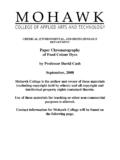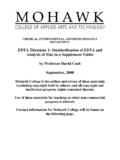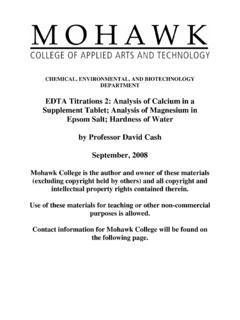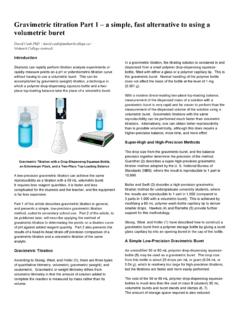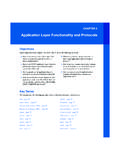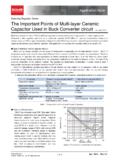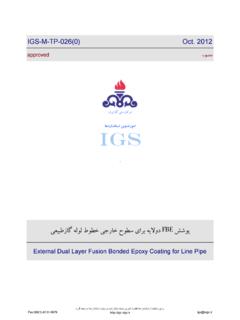Transcription of Thin Layer Chromatography (TLC) of Food Colour …
1 CHEMICAL, ENVIRONMENTAL, AND BIOTECHNOLOGY DEPARTMENT thin Layer Chromatography (TLC) of Food Colour Dyes by Professor David Cash September, 2008 Mohawk College is the author and owner of these materials (excluding copyright held by others) and all copyright and intellectual property rights contained therein. Use of these materials for teaching or other non-commercial purposes is allowed. Contact information for Mohawk College will be found on the following page. This Experiment is a 3 hour Organic Chemistry laboratory exercise. It is designed for students in the fourth term of a 3-year diploma program in Chemical or Environmental Technology. For Information or Assistance Contact: MOHAWK COLLEGE CHEMICAL, ENVIRONMENTAL, AND BIOTECHNOLOGY DEPARTMENT Professor Cindy Mehlenbacher 905-575-1212 ext.
2 3122 Bill Rolfe (Chief Technologist) 905-575-2234 1 Experiment 5 thin - Layer Chromatography Summary The technique of thin - Layer Chromatography (TLC) will be applied to investigate water soluble food dyes. The TLC plates to be used consist of a thin Layer of solid silica gel coated onto a flexible plastic material: Some food dye knowns will be investigated. Some food dye unknowns will be investigated using the same procedure. References Zubrick Topic 5th Edition 6th Edition 7th Edition Chromatography : Some Generalities pages 185-187 pages 218-220 pages 220-223 thin - Layer Chromatography pages 188-198 pages 221-233 pages 224-237 Shriner Topic 7th Edition 8th Edition thin - Layer Chromatography pages 59-63 pages 86-90 Skoog, Douglas A.
3 , West, Donald M., Holler, F. James, and Crouch, Stanley R., Fundamentals of Analytical Chemistry, 8th Edition, Thomson-Brooks/Cole, 2004; or Skoog, Douglas A., West, Donald M., and Holler, F. James, Fundamentals of Analytical Chemistry, 7th Edition, Saunders, 1996. Topic 7th Edition 8th Edition thin - Layer Chromatography pages 721-723 pages 1000-1003 2 Table of Dye Substances No. Name ( Colour ) Chemical Structure 1 tartrazine or FD&C Yellow 5 (yellow) SOONNaNONOONaNSOOONaO 2 sunset yellow or FD&C Yellow 6 (red-yellow) SOOONNaNHOSOOONa 3 erythrosine B or FD&C Red 3 (red) OOIIOIIOONaNa 4 allura red or FD&C Red 40 (red) SOOONNaNHOSOOONaOCH3CH3 5 brilliant blue FCF or FD&C Blue 1 (blue) NCH2C2H5 NCH2C2H5SO3 NaSO3 NaSO3 3 Table of Dye Substances (Cont.)
4 No. Name ( Colour ) Chemical Structure 6 indigo carmine or FD&C Blue 2 (blue) NHOSOOONaNHOSOOONa 7 fast green FCF or FD&C Green 3 (blue-green) HONCH2C2H5 NCH2C2H5SO3 NaSO3SO3Na 8 amaranth or FD&C Red 2 (purple) (Allowed in Canada but not allowed in the US) NaSOOONNNaNaHOSSOOOOOO 9 beta-carotene (orange) CH3CH3CH3CH3CH3CH3 0 lycopene (red-orange) CH3CH3CH3CH3CH3CH3 4 Background Information thin - Layer Chromatography This technique is well described in Zubrick, in Shriner, and in Skoog as listed in the Reference Section. thin - Layer Chromatography is an improvement on paper Chromatography because the more uniform particles used generally make the method more reproducible. It is a very fast and convenient method of performing separations for quality control and for screening unknown mixtures for their composition.
5 In the textile industry, both paper Chromatography and thin - Layer Chromatography are employed to make rapid determinations of the nature of dyes. It is very important to know if a given dye-stuff is a single substance or a mixture. This information is required particularly when the Colour of the fabric has to be corrected. Silica Gel This substance is commonly used as the stationary solid phase in thin - Layer Chromatography . Silica gel is an amorphous form of silica with a very porous structure. It is formed by acidification of aqueous sodium silicate. The initial gelatinous precipitate is washed free of all impurities and then roasted or spray dried. The material has typical pore diameters of 2200-2600 pm and a surface area of 750-800 m2 / g.
6 Food Dyes According to Pavia, Lampman, and Kriz, there were more than 90 dyes regularly used in foods prior to 1906, many of them also used as textile dyes. As scientific knowledge of the hazards has become more precise and government safety regulation more stringent, the number of allowed food dyes has been gradually decreased. In 1938, the number of food dyes allowed in the was 15, and in 1950 it was 19. At the present time (2006), there are 7 FD&C (food, drug, and cosmetic) dyes allowed for food use in the The same 7 and one other dye are allowed for food use in Canada. Some other dyes are also allowed in some other countries around the world. Supermarket Food Dyes The soluble food dyes available in Hamilton supermarkets are sold by McCormick Canada, which is a division or subsidiary of a U.
7 S. company, using the brand name Club House . Four colours are available, sold individually or in sets yellow, red, blue and green. The labels of the Club House products do not specify the dyes contained; however, the web site of the parent company ( ) does list the names of the dyes in each of the similar products. See the Table below. In this experiment you will determine if the Club House dyes have the same content as the McCormick dyes. 5 Table: Supermarket Food Dyes Food Dye Colour Club House Label McCormick Label Yellow Water, Propylene Glycol, Colours and Propylparaben as preservative Water, Propylene Glycol, FD&C Yellow 5, Propylparaben as preservative and FD&C Red 40 Red Water, Propylene Glycol, Colours and Propylparaben as preservative Water, Propylene Glycol, FD&C Red 40, FD&C Red 3 and Propylparaben as preservative Blue Water, Propylene Glycol, Colours and Propylparaben as preservative Water, Propylene Glycol, FD&C Blue 1, FD&C Red 40 and Propylparaben as preservative Green Water, Propylene Glycol, Colours and Propylparaben as preservative Water, Propylene Glycol, Yellow 5.
8 FD&C Blue 1 and Propylparaben as preservative The following sections are adapted from Experiment 13: Paper Chromatography , CHEM PH209 General Chemistry 2 Laboratory Manual. Chromatography Some analytical methods can be applied to samples which contain mixtures of substances, but most methods require that the components of the sample be separated first. Chromatography is the general name of a very important group of closely related separation methods. These methods use the differing physical properties of the substances to separate them. The method and name was invented around 1900 by a chemist (Tswett) who was able to separate the coloured pigments from plants, the yellow and red carotenes and the green chlorophylls, by passing an extract of pigments through a column packed with powdered chalk or sugar.
9 The name Chromatography means writing with Colour . The method was not important then because most substances are not coloured, and the only detector available at the time was the human eye. Modern Chromatography The first modern use of Chromatography came in the 1940 s. The biochemists studying proteins recognized that all protein was made from only 20 + component amino acids. Hydrolysis of purified proteins gave mixtures of amino acids that were impossible to separate by the classical methods, such as distillation or fractional crystallization. The chemists Martin and Synge developed paper Chromatography as a method of amino acid separation, and were awarded the Nobel Prize in Chemistry (1952) for this and further work.
10 Paper Chromatography and its close relative thin Layer Chromatography (TLC) are still very important methods used today. Since 1950, new methods called gas Chromatography (GC) and high pressure/performance liquid Chromatography (HPLC or LC) have been introduced which are even more important. The theory and practice of GC and HPLC are introduced in Chemical Instrumentation courses. 6 Technical Terms in Paper Chromatography Water is not often used for Chromatography , since better separations are usually achieved with mixed solvents. The experiment is always carried out in a closed chamber or tank. The liquid is called the travelling or mobile phase and the paper surface is the stationary phase.
